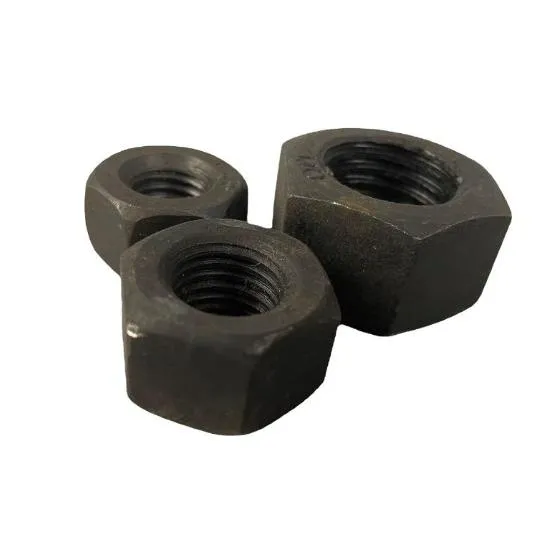

Unlocking Stability: The Science and Strength of the Lock Nut
Mei . 16, 2025 13:50 Kembali ke daftar
Unlocking Stability: The Science and Strength of the Lock Nut
In the fast-paced world of mechanical assembly and structural engineering, reliability starts with the smallest components. Among them, the mur pengunci stands as a silent hero, keeping everything tightly held together. From automotive applications to industrial machinery and structural steelwork, the mur pengunci has earned its place as an essential fastening element. This article dives into its inner mechanics, performance features, and why discerning buyers are shifting toward advanced options like mur pengunci hitam dan khusus jenis mur pengunci.

The Working Principle Behind the Lock Nut
At its core, a mur pengunci is designed to resist loosening when exposed to vibration or torque. This resistance is achieved through added friction within the threads or between mating surfaces. The most common mechanism includes a nylon insert, which compresses slightly and creates a tight grip on the bolt threads. Other jenis mur pengunci use deformed threads or additional locking devices like serrations or flanged faces to provide this resistance.
Unlike standard nuts, which can loosen due to repeated movement or temperature fluctuation, mur pengunci variations maintain their position and tension under stress. The fundamental physics lies in friction, interference, or both. As a result, these nuts are widely used in safety-critical assemblies where failure is not an option.
The Mechanical Edge: Advantages of Lock Nut Technology
When selecting a fastening system, the benefits of the mur pengunci design shine through. First, it drastically reduces the need for maintenance, as retightening is rarely required. Second, its performance remains consistent even under heavy vibration or load cycling. Third, high-strength mur pengunci hitam, often made from carbon steel and treated with anti-corrosion finishes, combine durability with aesthetic appeal, ideal for visible installations or harsh environments.
What separates modern jenis mur pengunci from conventional fasteners is their ability to be reused multiple times in some configurations without significant degradation. These nuts come in a wide range of sizes and styles, making them suitable for everything from electronic housings to heavy-duty bridges. Moreover, users value the way mur pengunci solutions reduce the chance of component failure, enhancing safety and system longevity.
Lock Nut vs Vibration: Test Methods and International Standards
To ensure the performance of the mur pengunci, manufacturers conduct stringent vibration and torque tests based on recognized global standards. A common benchmark is ISO 2320, which outlines functional tests such as loosening resistance under defined vibration cycles and torque performance at specific temperature ranges.
In a typical test, the mur pengunci is applied to a bolt on a vibration platform. The test measures any rotation or axial movement after thousands of cycles. When comparing jenis mur pengunci, this testing is crucial—while a nylon insert type may perform well in moderate conditions, an all-metal mur pengunci hitam variant could outperform it in high-temperature or heavy-load environments.
The vibration resistance performance is not just a quality assurance procedure—it’s also a key selling point. Distributors that adhere to these standards provide customers with peace of mind, especially in industries like aviation, rail transport, and seismic construction.
Exploring the Diversity of Lock Nut Types for Different Applications
Not all nuts are created equal. From flanged and slotted to prevailing torque and serrated types, the variety of jenis mur pengunci caters to specific use cases. For instance, mur pengunci hitam are often chosen for their rust-resistant finish and industrial appearance, making them suitable for outdoor and exposed applications.
Slotted mur pengunci designs are preferred in settings where precise preload adjustments are required, like in automotive suspensions. Meanwhile, flanged types provide extra surface area for load distribution, which reduces the risk of damage to softer materials.
Users benefit by selecting the correct type for their application, balancing torque strength, reusability, corrosion resistance, and appearance. For high-speed equipment, aerospace mechanisms, or structural support systems, the right mur pengunci can mean the difference between flawless performance and catastrophic failure.
Lock Nut FAQs
What is the primary function of a mur pengunci?
Itu mur pengunci serves to prevent loosening of the bolt under vibration, torque, or thermal expansion. It ensures a secure, long-lasting connection in critical assemblies.
Are mur pengunci hitam suitable for outdoor environments?
Yes. Black lock nuts are often coated with corrosion-resistant finishes like black oxide or phosphate, making them ideal for outdoor or industrial applications where moisture and chemicals are present.
What is the difference between nylon insert and all-metal jenis mur pengunci?
Nylon insert nuts offer good performance at moderate temperatures, while all-metal jenis mur pengunci are heat-resistant, more durable, and suitable for high-vibration or heavy-load conditions.
How do you determine which mur pengunci type to use?
Consider the operating environment, load requirements, temperature exposure, and assembly constraints. The right mur pengunci type aligns with the project’s mechanical and environmental needs.
Do all jenis mur pengunci meet international standards?
Reputable manufacturers test their jenis mur pengunci according to international standards like ISO 2320 or DIN 985. Always check for certification to ensure quality and performance reliability.
Berita terbaru
-
The Versatility of Threaded Rods for Your Projects
BeritaJun.11,2025
-
The Quality Hex Head Self Tapping Screws for Every Project
BeritaJun.11,2025
-
The Essential Fasteners for Every Project
BeritaJun.11,2025
-
High-Quality Flange Nuts for Your Next Project
BeritaJun.11,2025
-
Explore the Versatility of T Bolts for Your Projects
BeritaJun.11,2025
-
Explore the Best Slotted Channels for Your Projects
BeritaJun.11,2025

